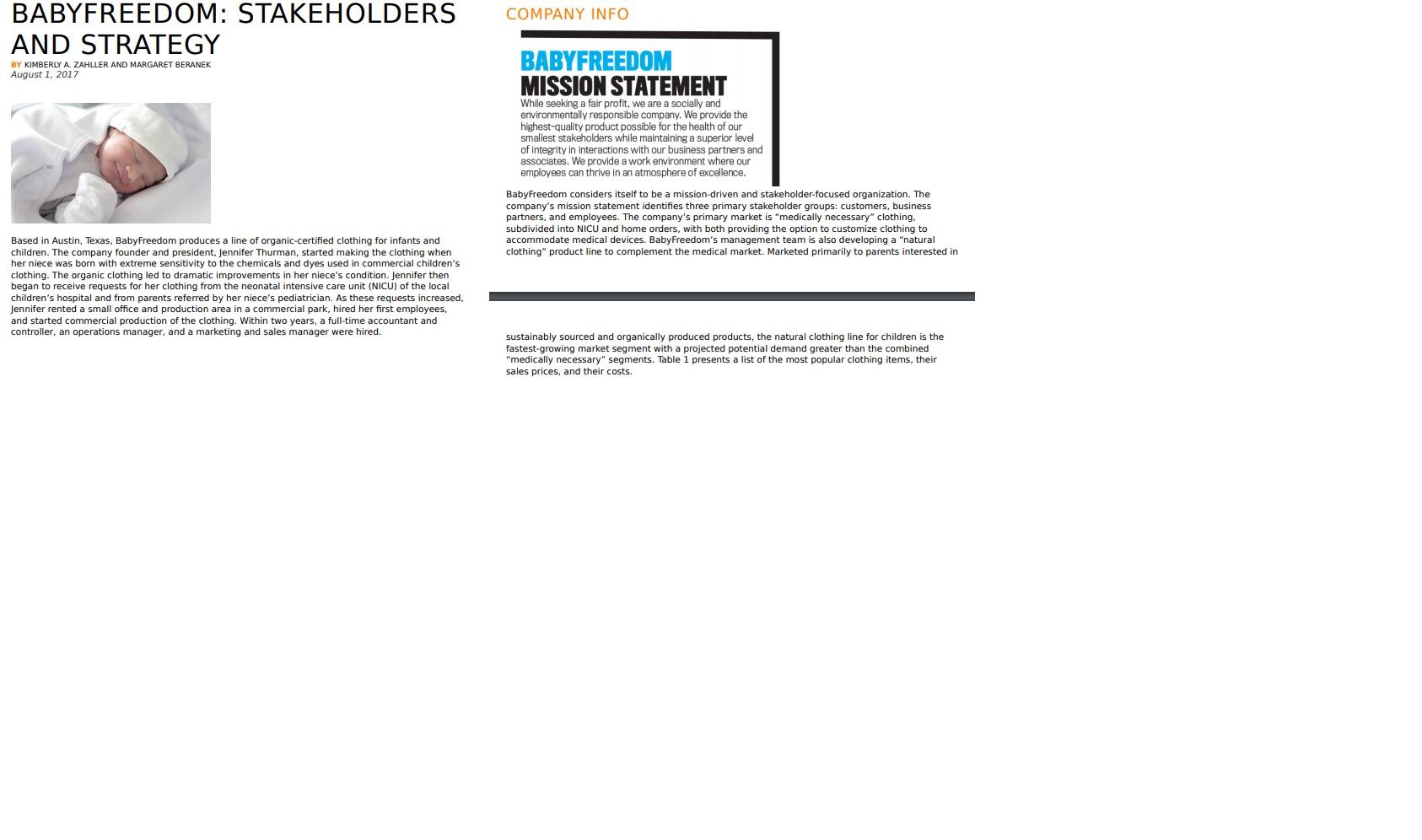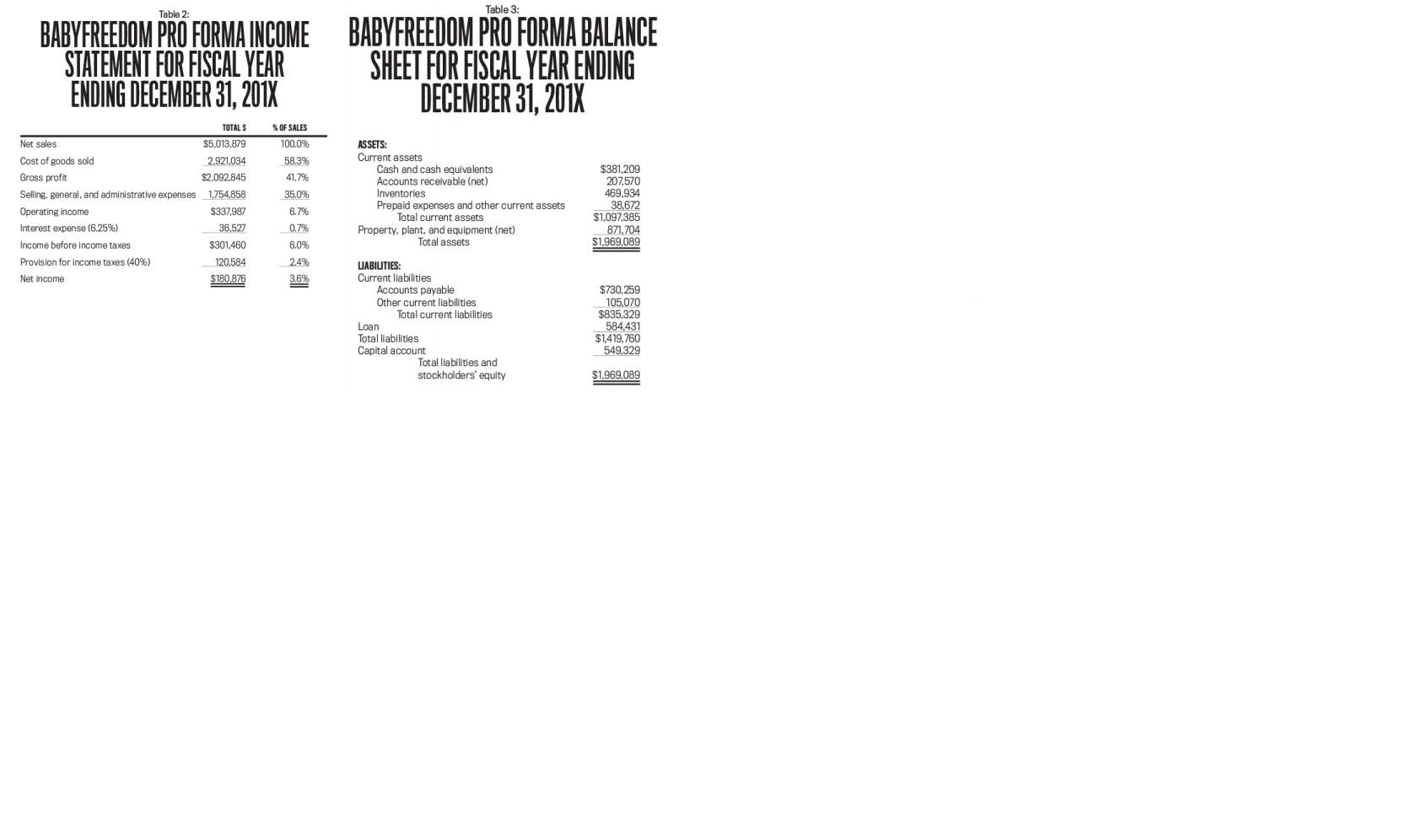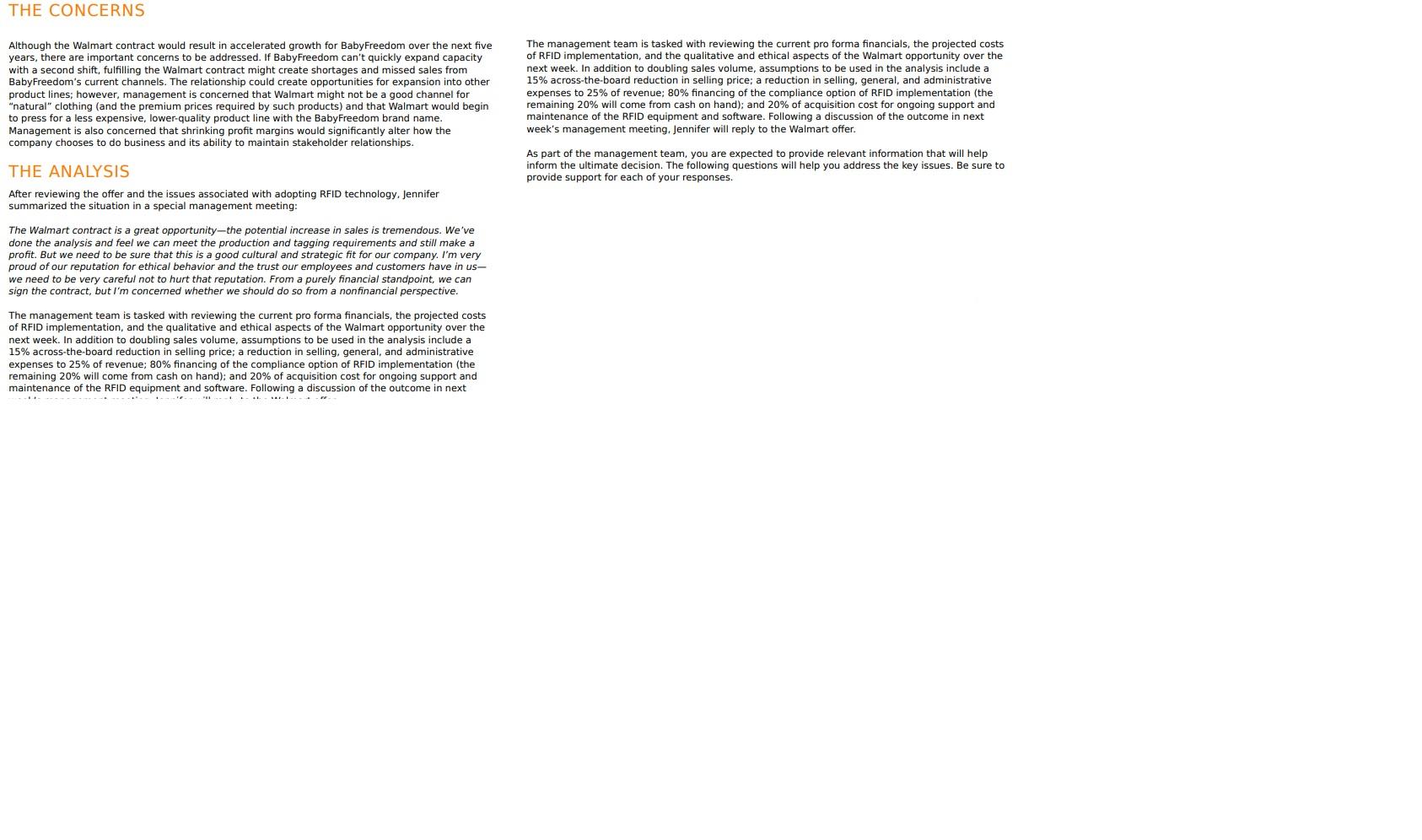Question
2. While the Walmart contract is large and would result in greater sales, there are many important quantitative and qualitative factors to consider, including strategic



 2. While the Walmart contract is large and would result in greater sales, there are many important quantitative and qualitative factors to consider, including strategic fit and stakeholder perceptions.
2. While the Walmart contract is large and would result in greater sales, there are many important quantitative and qualitative factors to consider, including strategic fit and stakeholder perceptions.
a. Using the assumptions given to BabyFreedoms management team and an initial acquisition cost of $25,000, construct a pro forma income statement incorporating the effects of accepting the Walmart contract. Use the mandated Walmart gross margin of 29.8%, and assume that BabyFreedom must maintain the same gross margin percentage for all revenues (in other words, it cant charge a different, higher price to its medically necessary or natural clothing customers).
b. The initial report stated that theres a positive NPV for the first five-year contract period with Walmart. Verify this by using Excel and the pro forma income statement constructed in 2(a) to calculate the NPV value, given a 40% tax rate and 6.25% weighted average cost of capital.
c. Michael Porters generic competitive strategies classify companies by how those companies pursue a competitive advantage across a chosen market. Which of Porters three strategies (cost leadership, differentiation, or focusiche) does BabyFreedom use? Which competitive strategy does Walmart use? Would a contract between the two companies be a good strategic fit? Why or why not? Do you think BabyFreedoms products in Walmart stores will alter how its brand is perceived? Explain.
d. BabyFreedom has a reputation for being a company with a strong sense of corporate social responsibility. BabyFreedoms natural (nonmedically necessary) clothing customer base is strongly oriented toward issues of sustainability, social responsibility, and ethical corporate behavior and is very focused on the companys reputation. Jennifer has stated that she doesnt want to alter her companys mission or values. Do you think a supplier relationship with Walmart reflects those values? Why or why not?
e. Beyond questions of strategic fit and company mission, are there other qualitative factors that should be considered in the decision? If the RFID technology wasnt an issue, do you think BabyFreedom should accept the Walmart contract? Why or why not? List and discuss alternative partners or sales channels that BabyFreedom could use to grow the company.
3. BabyFreedom is positioned as a socially responsible company producing high-quality natural clothing. List the stakeholders affected by the decision to accept or not accept the Walmart contract and implement basic RFID technology, and identify how they would be affected by the decision.
4. Based on your analysis, what is your recommendation regarding whether or not to accept the Walmart offer?
COMPANY INFO BABYFREEDOM: STAKEHOLDERS AND STRATEGY BY KIMBERLY A. ZAHLLER AND MARGARET BERANEK August 1, 2017 BABYFREEDOM MISSION STATEMENT While seeking a fair profit, we are a socially and environmentally responsible company. We provide the highest-quality product possible for the health of our smallest stakeholders while maintaining a superior level of Integrity in interactions with our business partners and associates. We provide a work environment where our employees can thrive in an atmosphere of excellence. Baby Freedom considers itself to be a mission-driven and stakeholder-focused organization. The company's mission statement identifies three primary stakeholder groups: customers, business partners, and employees. The company's primary market is "medically necessary" clothing, subdivided into NICU and home orders, with both providing the option to customize clothing to accommodate medical devices. BabyFreedom's management team is also developing a "natural clothing" product line to complement the medical market. Marketed primarily to parents interested in Based in Austin, Texas, BabyFreedom produces a line of organic-certified clothing for infants and children. The company founder and president, Jennifer Thurman, started making the clothing when her niece was bom with extreme sensitivity to the chemicals and dyes used in commercial children's clothing. The organic clothing led to dramatic improvements in her niece's condition. Jennifer then began to receive requests for her clothing from the neonatal intensive care unit (NICU) of the local children's hospital and from parents referred by her niece's pediatrician. As these requests increased, Jennifer rented a small office and production area in a commercial park, hired her first employees and started commercial production of the clothing. Within two years, a full-time accountant and controller, an operations manager, and a marketing and sales manager were hired. sustainably sourced and organically produced products, the natural clothing line for children is the fastest-growing market segment with a projected potential demand greater than the combined "medically necessary" segments. Table 1 presents a list of the most popular clothing items, their sales prices, and their costs. CURRENT PRICES AND COSTS FOR SELECTED PRODUCTS Throughout its existence, BabyFreedom has emphasized good relationships with suppliers. It also maintains a policy of selecting suppliers with reputations for being ethical and socially responsible. To that end, company managers regularly visit supplier sites and make a point of speaking with employees there to ensure the suppliers' reputations are based on fact. The suppliers tend to be smaller, family-run businesses, and BabyFreedom is usually their largest customer. To ensure reliability of supply and to build strong supplier relationships, BabyFreedom pays a premium for high- quality materials. PRICE ABSORPTION COST $8.25 11.00 The company also has a reputation for being an excellent place to work. Jennifer insists on safe, comfortable working conditions and provides healthcare coverage for all employees. The employees are mostly Mexican and Asian immigrant women, often with small children, and BabyFreedom 16.50 PRODUCT DESCRIPTION Intant, 0-24 months Kimono style shirt Roll waist pants Layette set (T-shirt, roll waist pants) Side-snap layette Convertible jumper Leggings with foot Cardigan Toddler, 2-4 years Jacket Dress Leggings T-shirt Pajama set Pullover Cardigan $15.00 20.00 30.00 50.00 60.00 40.00 50.00 32.50 39.00 26.00 32.50 $65.00 39.00 13.75 $100.00 60.00 25.00 25,00 40.00 50.00 provides a company daycare room for preschool children and an after-school tutor for school-age children. Workers also are encouraged to continue their education. As a result of this culture, voluntary turnover at the company is almost nonexistent, and several production workers have taken on increasing responsibility in staff functions in accounting, supply chain management, and operations. 13.75 26.00 32.50 5200 80.00 Customers are extremely loyal to the company. Surveys indicate that customers greatly value ethical, trustworthy companies that are socially and environmentally responsible and that they perceive BabyFreedom to have those qualities. Customers for the natural clothing line (nonmedically necessary) are especially concerned with issues of sustainability, fair trade, and social responsibility. To address these concerns, BabyFreedom's website includes a great deal of information about its suppliers and employees, including photos and interviews. The company also regularly solicits customer comments and suggestions on its website and from flyers included with product packaging Table 2 Table 3: BABYFREEDOM PRO FORMA INCOME BABYFREEDOM PRO FORMA BALANCE STATEMENT FOR FISCAL YEAR SHEET FOR FISCAL YEAR ENDING ENDING DECEMBER 31, 2018 DECEMBER 31, 2018 TOTALS Net sales Cost of goods sold Gross profit Selling, general, and administrative expenses Operating income Interest expense (6.25%) Income before income taxes Provision for income taxes (40%) Net income $5,013,879 2.921,034 $2,092,845 1.754,858 $337.987 36,527 $301.460 120,584 $180,876 OF SALES 100.0% 58.3% 41.7% 35.0% 6.79 0.7% ASSETS: Current assets Cash and cash equivalents Accounts receivable (net) Inventories Prepaid expenses and other current assets Total current assets Property, plant, and equipment (net) Total assets $381,209 207,570 469.934 38,672 $1,097,385 871,704 $1,969,089 6.0% 2.4% 3.6% LIABILITIES: Current liabilities Accounts payable Other current liabilities Total current liabilities Loan Total liabilities Capital account Total liabilities and stockholders' equity $730,259 105,070 $835,329 584.431 $1,419,760 549,329 $1,969,089 THE CONCERNS Although the Walmart contract would result in accelerated growth for BabyFreedom over the next five years, there are important concerns to be addressed. If BabyFreedom can't quickly expand capacity with a second shift, fulfilling the Walmart contract might create shortages and missed sales from BabyFreedom's current channels. The relationship could create opportunities for expansion into other product lines; however, management is concerned that Walmart might not be a good channel for "natural" clothing (and the premium prices required by such products) and that Walmart would begin to press for a less expensive, lower-quality product line with the BabyFreedom brand name. Management is also concerned that shrinking profit margins would significantly alter how the company chooses to do business and its ability to maintain stakeholder relationships. The management team is tasked with reviewing the current pro forma financials, the projected costs of RFID implementation, and the qualitative and ethical aspects of the Walmart opportunity over the next week. In addition to doubling sales volume, assumptions to be used in the analysis include a 15% across-the-board reduction selling price; a reduction in selling, general, and administrative expenses to 25% of revenue: 80% financing of the compliance option of RFID implementation (the remaining 20% will come from cash on hand); and 20% of acquisition cost for ongoing support and maintenance of the RFID equipment and software. Following a discussion of the outcome in next week's management meeting, Jennifer will reply to the Walmart offer. As part of the management team, you are expected to provide relevant information that will help inform the ultimate decision. The following questions will help you address the key issues. Be sure to provide support for each of your responses. THE ANALYSIS After reviewing the offer and the issues associated with adopting RFID technology, Jennifer summarized the situation in a special management meeting: The Walmart contract is a great opportunity-the potential increase in sales is tremendous. We've done the analysis and feel we can meet the production and tagging requirements and still make a profit. But we need to be sure that this is a good cultural and strategic fit for our company. I'm very proud of our reputation for ethical behavior and the trust our employees and customers have in us- we need to be very careful not to hurt that reputation. From a purely financial standpoint, we can sign the contract, but I'm concerned whether we should do so from a nonfinancial perspective. The management team is tasked with reviewing the current pro forma financials, the projected costs of RFID implementation, and the qualitative and ethical aspects of the Walmart opportunity over the next week. addition to doubling sales volume, assumptions to be used in the analysis include a 15% across-the-board reduction in selling price; a reduction in selling, general, and administrative expenses to 25% of revenue; 80% financing of the compliance option of RFID implementation (the remaining 20% will come from cash on hand); and 20% of acquisition cost for ongoing support and maintenance of the RFID equipment and software. Following a discussion of the outcome in next ........ " COMPANY INFO BABYFREEDOM: STAKEHOLDERS AND STRATEGY BY KIMBERLY A. ZAHLLER AND MARGARET BERANEK August 1, 2017 BABYFREEDOM MISSION STATEMENT While seeking a fair profit, we are a socially and environmentally responsible company. We provide the highest-quality product possible for the health of our smallest stakeholders while maintaining a superior level of Integrity in interactions with our business partners and associates. We provide a work environment where our employees can thrive in an atmosphere of excellence. Baby Freedom considers itself to be a mission-driven and stakeholder-focused organization. The company's mission statement identifies three primary stakeholder groups: customers, business partners, and employees. The company's primary market is "medically necessary" clothing, subdivided into NICU and home orders, with both providing the option to customize clothing to accommodate medical devices. BabyFreedom's management team is also developing a "natural clothing" product line to complement the medical market. Marketed primarily to parents interested in Based in Austin, Texas, BabyFreedom produces a line of organic-certified clothing for infants and children. The company founder and president, Jennifer Thurman, started making the clothing when her niece was bom with extreme sensitivity to the chemicals and dyes used in commercial children's clothing. The organic clothing led to dramatic improvements in her niece's condition. Jennifer then began to receive requests for her clothing from the neonatal intensive care unit (NICU) of the local children's hospital and from parents referred by her niece's pediatrician. As these requests increased, Jennifer rented a small office and production area in a commercial park, hired her first employees and started commercial production of the clothing. Within two years, a full-time accountant and controller, an operations manager, and a marketing and sales manager were hired. sustainably sourced and organically produced products, the natural clothing line for children is the fastest-growing market segment with a projected potential demand greater than the combined "medically necessary" segments. Table 1 presents a list of the most popular clothing items, their sales prices, and their costs. CURRENT PRICES AND COSTS FOR SELECTED PRODUCTS Throughout its existence, BabyFreedom has emphasized good relationships with suppliers. It also maintains a policy of selecting suppliers with reputations for being ethical and socially responsible. To that end, company managers regularly visit supplier sites and make a point of speaking with employees there to ensure the suppliers' reputations are based on fact. The suppliers tend to be smaller, family-run businesses, and BabyFreedom is usually their largest customer. To ensure reliability of supply and to build strong supplier relationships, BabyFreedom pays a premium for high- quality materials. PRICE ABSORPTION COST $8.25 11.00 The company also has a reputation for being an excellent place to work. Jennifer insists on safe, comfortable working conditions and provides healthcare coverage for all employees. The employees are mostly Mexican and Asian immigrant women, often with small children, and BabyFreedom 16.50 PRODUCT DESCRIPTION Intant, 0-24 months Kimono style shirt Roll waist pants Layette set (T-shirt, roll waist pants) Side-snap layette Convertible jumper Leggings with foot Cardigan Toddler, 2-4 years Jacket Dress Leggings T-shirt Pajama set Pullover Cardigan $15.00 20.00 30.00 50.00 60.00 40.00 50.00 32.50 39.00 26.00 32.50 $65.00 39.00 13.75 $100.00 60.00 25.00 25,00 40.00 50.00 provides a company daycare room for preschool children and an after-school tutor for school-age children. Workers also are encouraged to continue their education. As a result of this culture, voluntary turnover at the company is almost nonexistent, and several production workers have taken on increasing responsibility in staff functions in accounting, supply chain management, and operations. 13.75 26.00 32.50 5200 80.00 Customers are extremely loyal to the company. Surveys indicate that customers greatly value ethical, trustworthy companies that are socially and environmentally responsible and that they perceive BabyFreedom to have those qualities. Customers for the natural clothing line (nonmedically necessary) are especially concerned with issues of sustainability, fair trade, and social responsibility. To address these concerns, BabyFreedom's website includes a great deal of information about its suppliers and employees, including photos and interviews. The company also regularly solicits customer comments and suggestions on its website and from flyers included with product packaging Table 2 Table 3: BABYFREEDOM PRO FORMA INCOME BABYFREEDOM PRO FORMA BALANCE STATEMENT FOR FISCAL YEAR SHEET FOR FISCAL YEAR ENDING ENDING DECEMBER 31, 2018 DECEMBER 31, 2018 TOTALS Net sales Cost of goods sold Gross profit Selling, general, and administrative expenses Operating income Interest expense (6.25%) Income before income taxes Provision for income taxes (40%) Net income $5,013,879 2.921,034 $2,092,845 1.754,858 $337.987 36,527 $301.460 120,584 $180,876 OF SALES 100.0% 58.3% 41.7% 35.0% 6.79 0.7% ASSETS: Current assets Cash and cash equivalents Accounts receivable (net) Inventories Prepaid expenses and other current assets Total current assets Property, plant, and equipment (net) Total assets $381,209 207,570 469.934 38,672 $1,097,385 871,704 $1,969,089 6.0% 2.4% 3.6% LIABILITIES: Current liabilities Accounts payable Other current liabilities Total current liabilities Loan Total liabilities Capital account Total liabilities and stockholders' equity $730,259 105,070 $835,329 584.431 $1,419,760 549,329 $1,969,089 THE CONCERNS Although the Walmart contract would result in accelerated growth for BabyFreedom over the next five years, there are important concerns to be addressed. If BabyFreedom can't quickly expand capacity with a second shift, fulfilling the Walmart contract might create shortages and missed sales from BabyFreedom's current channels. The relationship could create opportunities for expansion into other product lines; however, management is concerned that Walmart might not be a good channel for "natural" clothing (and the premium prices required by such products) and that Walmart would begin to press for a less expensive, lower-quality product line with the BabyFreedom brand name. Management is also concerned that shrinking profit margins would significantly alter how the company chooses to do business and its ability to maintain stakeholder relationships. The management team is tasked with reviewing the current pro forma financials, the projected costs of RFID implementation, and the qualitative and ethical aspects of the Walmart opportunity over the next week. In addition to doubling sales volume, assumptions to be used in the analysis include a 15% across-the-board reduction selling price; a reduction in selling, general, and administrative expenses to 25% of revenue: 80% financing of the compliance option of RFID implementation (the remaining 20% will come from cash on hand); and 20% of acquisition cost for ongoing support and maintenance of the RFID equipment and software. Following a discussion of the outcome in next week's management meeting, Jennifer will reply to the Walmart offer. As part of the management team, you are expected to provide relevant information that will help inform the ultimate decision. The following questions will help you address the key issues. Be sure to provide support for each of your responses. THE ANALYSIS After reviewing the offer and the issues associated with adopting RFID technology, Jennifer summarized the situation in a special management meeting: The Walmart contract is a great opportunity-the potential increase in sales is tremendous. We've done the analysis and feel we can meet the production and tagging requirements and still make a profit. But we need to be sure that this is a good cultural and strategic fit for our company. I'm very proud of our reputation for ethical behavior and the trust our employees and customers have in us- we need to be very careful not to hurt that reputation. From a purely financial standpoint, we can sign the contract, but I'm concerned whether we should do so from a nonfinancial perspective. The management team is tasked with reviewing the current pro forma financials, the projected costs of RFID implementation, and the qualitative and ethical aspects of the Walmart opportunity over the next week. addition to doubling sales volume, assumptions to be used in the analysis include a 15% across-the-board reduction in selling price; a reduction in selling, general, and administrative expenses to 25% of revenue; 80% financing of the compliance option of RFID implementation (the remaining 20% will come from cash on hand); and 20% of acquisition cost for ongoing support and maintenance of the RFID equipment and software. Following a discussion of the outcome in nextStep by Step Solution
There are 3 Steps involved in it
Step: 1

Get Instant Access to Expert-Tailored Solutions
See step-by-step solutions with expert insights and AI powered tools for academic success
Step: 2

Step: 3

Ace Your Homework with AI
Get the answers you need in no time with our AI-driven, step-by-step assistance
Get Started


